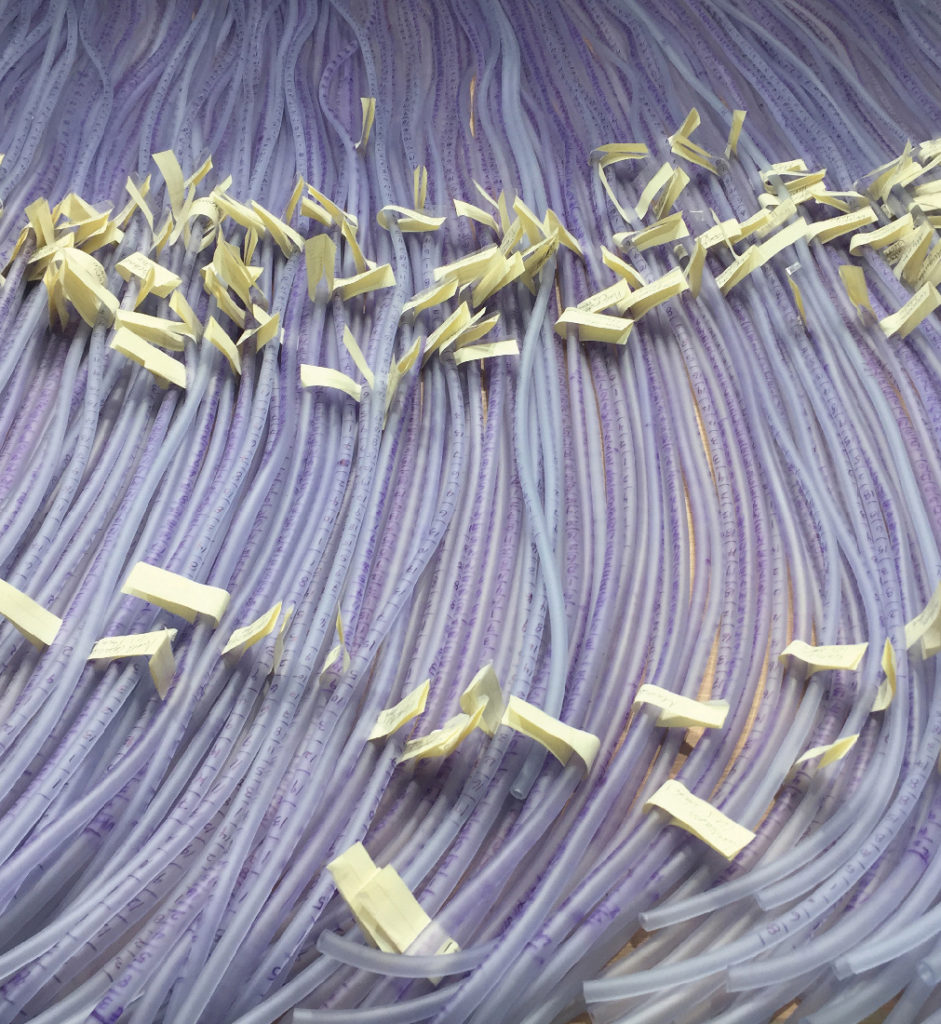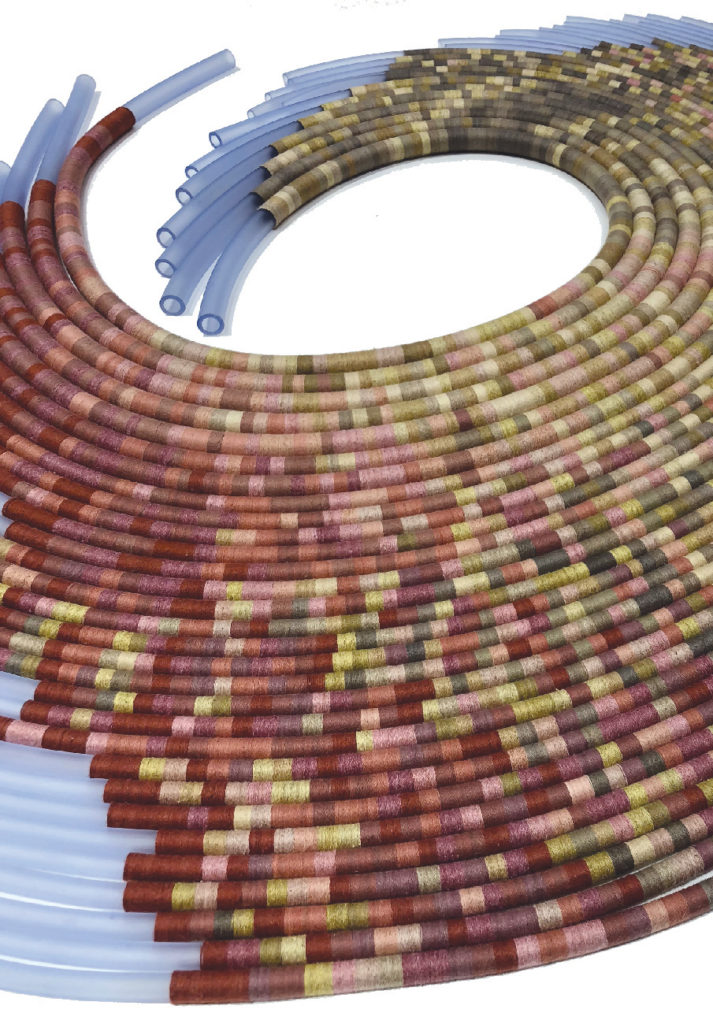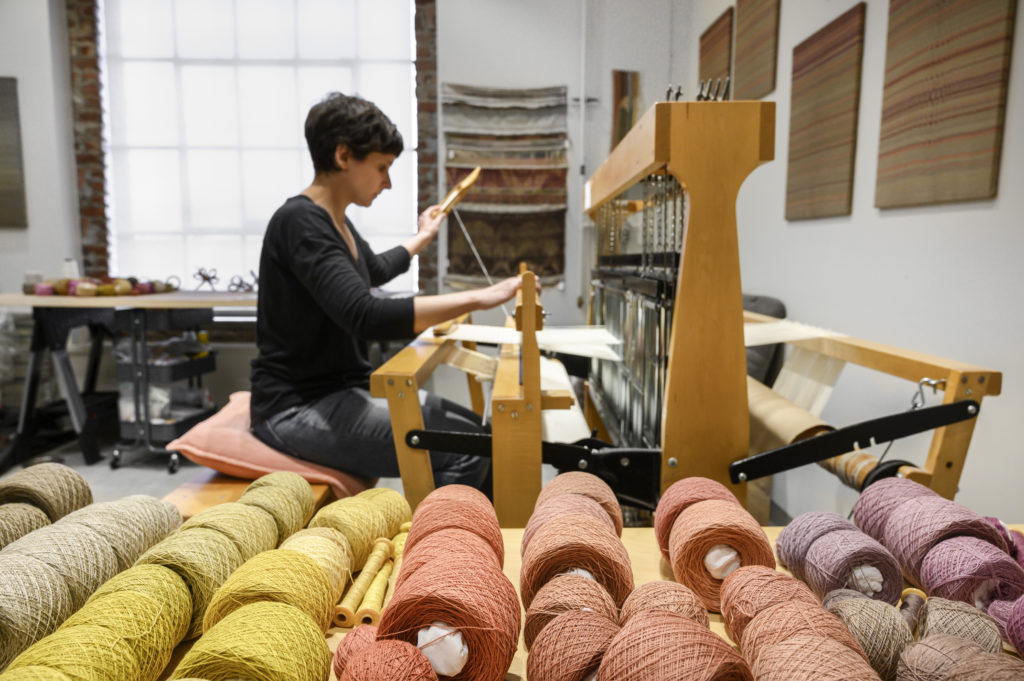WIP Artist Highlight: Tali Weinberg
Tali Weinberg is a textile artist, teacher, activist, and writer who has dedicated the recent years of her artistic practice to making woven and sculptural work about climate change. As our July Work-in-Progress Artist, Tali is working on completing a long-term coiled sculpture called Bound, which involves the translation of climate change data into rhythms of color, shape, and line.
Saying her work is a catalyst for climate change discourse is an understatement - it is, alone, a silent, entangled dialogue that may allow for some serious contemplation and emotional unraveling.

Tali has been working on the final iteration of Bound, which involves the translation of 300 sets of climate data for 300 places into 1500 feet of medical tubing wrapped with threads dyed with plant and insect-derived dyes. Twenty individual thread colors, from shades of muted green to rusty red earth tones, are used to translate the rate of change in annual average temperature into a scale ranging from 1-20. Copied from the National Oceanic and Atmospheric Administration (NOAA), the 300 datasets range in geographic scale from cities to the globe.
The shape-shifting sculpture has evolved and been exhibited in multiple iterations. “Each iteration explores a different aspect of our relationship to the climate crisis,” Tali explains. In the first, 15 data sets were arranged in a 65”x22”x10” entanglement of knots, “reflecting how entangled we are with the petrochemical industry and how data sometimes obscures the real violence of climate change.” In the second iteration, 32 of the 300 datasets were arranged in a wavelike form, reminiscent of a storm map, and were exhibited in Asheville, NC soon after the hurricane struck the coast in 2018.

"Bound is a sculpture that traces multiple forms of entanglement in the face of anthropogenic climate change. It is a project that explores the relationship between the damage done to the earth and the damage done to our bodies by the petrochemical industry, even as our lives are reliant on and seemingly inextricably intertwined with this industry. Petrochemical-derived medical tubing is a pipeline that runs through and around our bodies, used in medical interventions for illnesses that often have the same causes as ecological destruction."
The more I speak to Tali about her work, the more I notice the brilliant nuances to her formal and conceptual artistic choices. This was followed by a simple but potent realization I had during our conversation: as the earth experiences climate change, so do we experience a shift in our own emotional climate in response to this disharmony. A sense of chaos, disorder, and imbalance we experience in the natural world is one that is mirrored by our individual experience. I wonder if the notion of entanglement Tali is continually drawn to investigate in her work could also be thought of as interconnectedness.
Weaving, as a form of art, craft, and trade, entwines many forms of knowledge. “It is cerebral and embodied, mathematical and creative, material, social, and conceptual, political and personal,” Tali illumined. Seeing weaving as a metaphor for social change, where even “within the constraints of the loom there is infinite possibility,” and where “we can create our own structures and systems,” Tali’s work challenges the cynicism that often emerges in conversations about climate change, offering an alternate lens through which to experience this data.
“Textiles are also a language,” Tali notes. “There is a long history and mythology of weaving as a subversive language for women and other marginalized people. In this context, and in our current political moment, the work becomes a kind of feminist archive and also a text that prioritizes relation rather than representation.”

My eyes carefully scan the stripes of color that extend across wrapped petrochemical-derived tubing spread out on Tali’s workspace, and I notice something else: the individual cities represented by each piece of medical tubing may be experiencing climate change differently, yet they are connected by their shared condition. Parallel to this system, textiles are comprised of individual strands of fiber that are arranged to form a structure, whether they are woven, knitted, or nonwoven. Acting as a tactile embodiment of the climate data we are so often confronted with, but can’t always form a response to, Tali’s work truly gives us the time and space to sit with our abstract thoughts and emotions toward climate change, materializing them into a more actualized experience.
As part of her residency here at TAC, Tali invites you to partake in Sensing Climate - Weaving Data, this Saturday, July 27th, 10am-5pm, where you’ll materialize climate data into a small woven tapestry. Tali will guide participants through reflections on landscape, color, and one's relationship to place in the context of anthropogenic climate change.
For more information, and to RSVP, please visit: https://www.eventbrite.com/e/sensing-climate-weaving-data-workshop-with-tali-weinberg-tickets-65025616369
To follow Tali's work and practice, follow her Instagram: @tali.weinberg